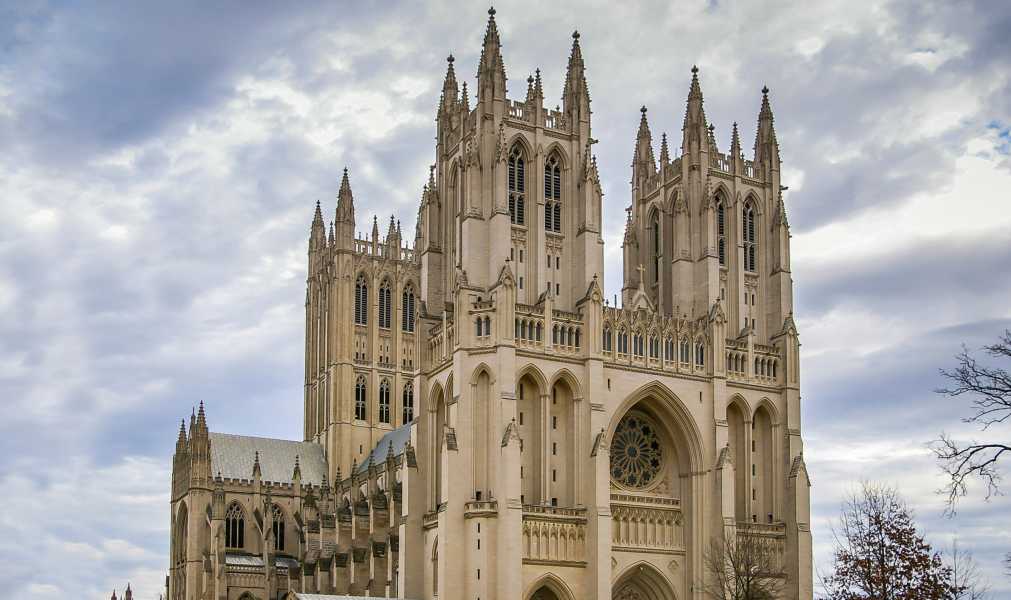The dedication of a pillow marks the passing of an American—something.

Credit: FredP
It is a melancholy thing to reread the speech that George H.W. Bush gave in September 1990 at the laying of Washington National Cathedral’s final stone. “We have constructed here this symbol of our nation’s spiritual life, overlooking the center of our nation’s secular life,” he said, “a symbol which combines the permanence of stone and of God—both of which will outlast men and memories—a symbol that carries with it a constant reminder of our moral obligations.”
True words, but I don’t think Bush could have guessed that, even before he died, the Cathedral would already be outlasting memory. These days the church is cavernous, echoey, and broken—shaken a decade ago by an earthquake from which it will probably never recover—still a reminder of our moral obligations, though now, I think, the thing looks more like a warning. In that same speech, Bush remarked that whenever he looked up Wisconsin Avenue and saw the Cathedral, seemingly floating over the city, he felt as if God himself were issuing a challenge. I know that feeling well; I suspect even those with no faith at all, walking down on the Virginia side of the Potomac and happening to look up, know it too.
Earlier this week, I found myself in the Cathedral for what will likely be the penultimate Bush family ceremony to occur within its walls—George W. Bush’s funeral, of course, will be the last. Finally, five years after the president’s death, the Cathedral’s volunteer needlepoint committee had organized and completed a commemorative kneeling cushion in the elder Bush’s honor. There are more than two thousand pieces of needlepoint in the church, many of them designed and stitched by volunteers, those excellent women who, until rather recently, were never in short supply.
Bush’s cushion is part of a long-running series of kneelers that pay tribute to famous and important Americans. There are about two hundred of them, and they are collected in the Cathedral’s Saint John’s Chapel, one of my favorite places in the whole building. The selection and presentation of these kneelers is a catalog—in a goofy way that only 20th-century Episcopalians could have devised—of American saints.
Most of the dead presidents are represented there. (I sometimes wonder if the last few holders of that office will make the cut.) The mainstays of our national literature are also represented, as well as our scientists, men of industry, and war heroes. Each cushion attempts to represent the high points of the saint’s life, some with more success than others.
Washington Irving’s cushion, for instance, is a straightforward affair: Rip Van Winkle, the Headless Horseman, Tarrytown. Willa Cather’s requires a little bit more interpretation: It depicts a few books within the outline of the state of Nebraska. In my opinion, the most amusing of the cushions is that of poor Gerald Ford. The needlepoint committee chose to represent his life with the presidential seal, the outline of a football, an Eagle Scout badge, and the dome of the Capitol.
Bush’s own cushion is more Ford than Irving. It depicts the presidential seal, his World War II plane, an abstract rendition of his estate in Kennebunkport, and, in a self-referential nod, National Cathedral. When it is brought into the church, at the tail end of the procession for evensong, it is treated with the reverence due to a sacred object. The presidential historian Jon Meacham (also a canon of the Cathedral) preaches over the cushion in his clerics, reminding the crowd gathered in the Great Choir that, for all his faults, Bush saw himself as a servant of God and attempted in his way to live up to that self-conception. It was an admirable, if somewhat limited, faith.
At length, the dean of the Cathedral, the Very Reverend Randolph Marshall Hollerith, ascended to the high altar where he blessed the cushion as it lay there alone, like a Eucharistic offering.
Subscribe Today Get daily emails in your inbox Email Address:
“Almighty God, we thank you that you have put it into the hearts of your people to make offerings for your service, and have been pleased to accept their gifts,” he said. “Be with us now and bless us as we set apart this cushion to your praise and glory and in honor of George Herbert Walker Bush; through Jesus Christ our Lord.”
A lot of people wring their hands over this kind of thing. Civil religion, even in its most absurd forms, will always be suspect to most Americans. But all of us there that night are Washingtonians; we are bound by civil religion. After Hollerith blessed the cushion, he led the congregation in giving God thanks for permitting the handiwork of the volunteer needlepoint committee to glorify him: “Solomon beautified the sanctuary, and multiplied the vessels of the temple. Oh, the majesty and magnificence of God’s presence!” And the congregation responded dutifully: “Oh, the power and the splendor of his sanctuary!”
When the ceremony ended, the crowd of blue blazers and Shetland sweaters did not leave immediately. Instead, they quietly formed an orderly line to pay their respects to the cushion, as Catholics do to the cross on Good Friday. I stood in the back and waited until almost everyone had gone, leaving the cushion alone on the altar. The last light of evening faded. By the end, the church was dark.
Sourse: theamericanconservative.com